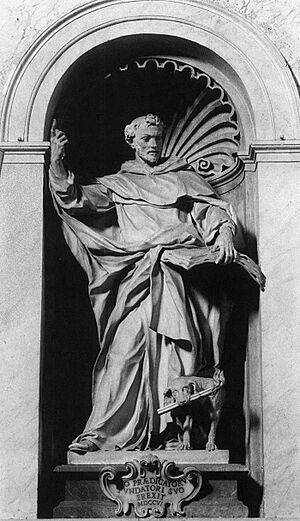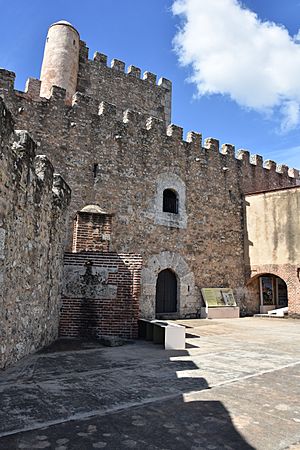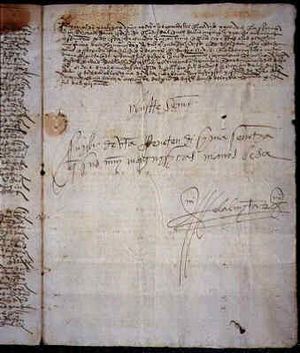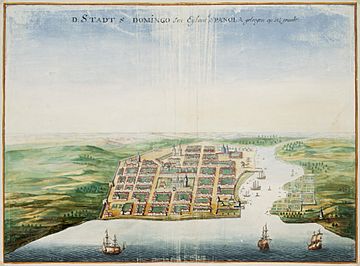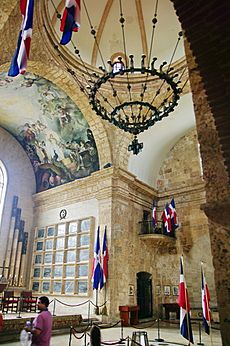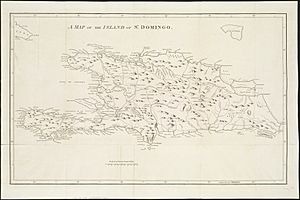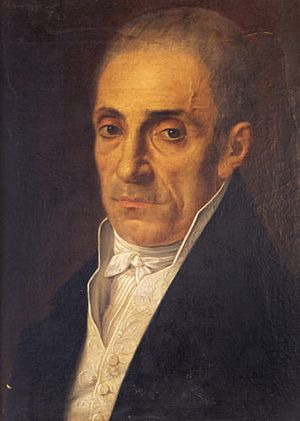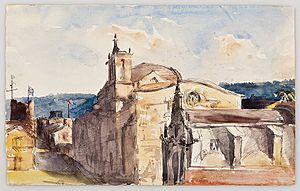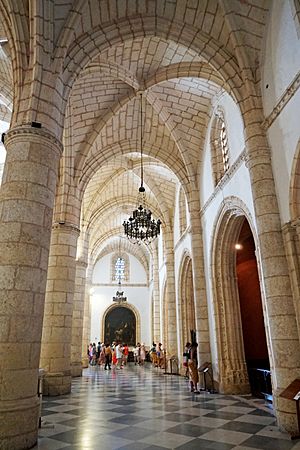Captaincy General of Santo Domingo facts for kids
Quick facts for kids
Captaincy General of Santo Domingo
Capitanía General de Santo Domingo (Spanish)
|
|||||||||||
|---|---|---|---|---|---|---|---|---|---|---|---|
| 1535-1795, 1809-1821 ,1861-1865 | |||||||||||
|
|
|||||||||||
|
Anthem: Marcha Real
("Royal March") |
|||||||||||
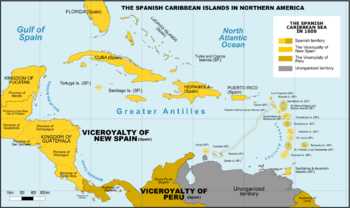
Spanish Caribbean around 1600. The Captaincy General of Santo Domingo in the center.
|
|||||||||||
| Status | Colony of New Spain | ||||||||||
| Capital | Santo Domingo | ||||||||||
| Common languages | Spanish | ||||||||||
| Religion | Roman Catholicism | ||||||||||
| Demonym(s) | Dominican | ||||||||||
| Government | Monarchy | ||||||||||
| King | |||||||||||
|
• 1493–1516
|
Ferdinand II and Isabella I (first) |
||||||||||
|
• 1788–1795
|
Charles IV (last) | ||||||||||
| Governor | |||||||||||
|
• 1493–1500
|
Christopher Columbus (First) | ||||||||||
|
• 1788–1801
|
Joaquín García y Moreno (Last) | ||||||||||
| History | |||||||||||
|
• Human settlement
|
Before 1493 | ||||||||||
|
• European settlement
|
1535-1795, 1809-1821 ,1861-1865 | ||||||||||
|
• Treaty of Ryswick, ceded western portion to France
|
1697 | ||||||||||
| Currency | Santo Domingo real | ||||||||||
|
|||||||||||
| Today part of | Dominican Republic Haiti |
||||||||||
The Captaincy General of Santo Domingo (Spanish: Capitanía General de Santo Domingo) was the first European colony in the New World. It was set up by Spain in 1492 on the island of Hispaniola. This colony was very important because it controlled many Spanish lands in the Caribbean. It also managed most of the nearby mainland coasts. This made Santo Domingo the main Spanish power in the early colonial times.
Because of its great location, the Captaincy General of Santo Domingo was a base for Spanish explorers. They used it before heading to the mainland. It also helped set up other European colonies in the Americas. The city of Santo Domingo was the first European city built in the Americas. It also has the oldest castle, fortress, cathedral, and monastery in the region. The colony was a place where European explorers, soldiers, and settlers met. They brought their culture, buildings, laws, and traditions from the Old World.
The colony stayed a strong military base for Spain for over 100 years. It successfully fought off attacks from British, Dutch, and French forces until the early 1600s. Later, pirates working for France took over part of the west coast. French settlers then arrived, leading to many years of fighting. Spain finally gave the western third of Hispaniola to France in 1697. This was part of the Peace of Ryswick treaty. This event created the basis for the future countries of the Dominican Republic and Haiti.
Contents
History of Santo Domingo
The Island Before Columbus
Before Christopher Columbus and the Spanish arrived in 1492, the island was home to the native Taíno people. They called their island Ayiti (meaning "land of high mountains") or "Quisqueya" (meaning "great thing" or "big land"). The Spanish later named it Hispaniola. At that time, the island had five main areas called chiefdoms. These were Marién, Maguá, Maguana, Jaragua, and Higüey. Each chiefdom was led by a cacique (chief).
Spanish Arrival and First Settlements
In 1492, on his first trip, Christopher Columbus landed on a large island in the Caribbean. He quickly claimed the island for the Spanish Crown. He named it La Isla Española, which later became Hispaniola. Columbus built a settlement in the north of the island. However, the local people later attacked it. The Taínos had a system where everyone was equal. This was very different from the European system, which had strict social classes. The Europeans treated the Taíno tribes with violence.
After his ship, the Santa María, sank, Columbus built a military fort. He called it La Navidad because it was built on Christmas Day. While Columbus was away, the soldiers at the fort fought among themselves. Some of them began to harm the Taíno people. The strong Cacique Caonabo from the Maguana Chiefdom attacked the Europeans and destroyed La Navidad.
In 1493, Columbus came back to the island on his second voyage. He founded the first Spanish colony in the New World, the city of Isabella. In 1496, his brother Bartholomew Columbus started a new settlement. It was called Santo Domingo de Guzmán on the southern coast. This became the new capital. About 400,000 Taínos lived on the island. Many were forced to work in gold mines. By 1508, their numbers had dropped to about 60,000. This was due to forced labor, hunger, sickness, and violence. By 1535, only a few dozen Taínos were still alive.
Santo Domingo became the first European city in the Americas. It was founded by Bartholomew Columbus in 1496. He first named it La Nueva Isabela, after an earlier settlement and Queen Isabella I of Spain. In 1495, it was renamed "Santo Domingo" to honor Saint Dominic.
Santo Domingo: Gateway to the New World
Santo Domingo became known as the "Gateway to the New World." It was the main city and capital for all Spanish colonies in the Americas during the early colonization. Many important Spanish expeditions started from Santo Domingo. These included Juan Ponce de León's trip to Puerto Rico, Diego Velázquez de Cuéllar's trip to Cuba, Hernando Cortes' conquest of Mexico, and Vasco Núñez de Balboa's discovery of the Pacific Ocean.
A large amount of gold was found in the Cordillera Central mountains. This led to a gold rush from 1500 to 1508. Ferdinand II of Aragon ordered that gold from the richest mines be kept for the Crown. In the first 20 years, about 30,000 kilograms of gold were taken from the island. This was more gold than all of Europe produced at that time.
The Spanish leaders of the colony changed several times. When Columbus left for another exploration, Francisco de Bobadilla became governor. Settlers complained about Columbus's leadership, causing political problems. In 1502, Nicolás de Ovando replaced de Bobadilla as governor. He treated the Taíno people very harshly. In June 1502, a big hurricane destroyed Santo Domingo. Governor Ovando had it rebuilt on a new site across the Ozama River.
In 1503, the Hospital San Nicolás de Bari began construction. It was the first hospital in the Americas. This big project was meant to be like the grand buildings in Europe. It was inspired by Renaissance Italy. When finished, the hospital could hold up to 70 patients. This was similar to the best hospitals in Rome at the time.
In 1509, the Reales Atarazanas (Royal Shipyards) started being built. This building by the water held shipyards, warehouses, and tax offices. It also served as the first customs and tax house in the New World.
Enslavement of Africans
The Spanish monarchs, Ferdinand I and Isabella, allowed colonists to bring African slaves to the Caribbean. In 1510, the first large group of 250 enslaved people arrived from Spain. Eight years later, enslaved people born in Africa arrived in the West Indies. Sugar cane was brought to Hispaniola from the Canary Islands. The first sugar mill in the New World was built in 1516.
More workers were needed for the growing sugar cane farms. This led to a huge increase in the number of enslaved people brought to the island. Sugar mill owners became a new powerful group. They convinced the Spanish king to let them choose members of the Real Audiencia (a high court).
The first major slave revolt in the Americas happened in Santo Domingo on December 26, 1522. Enslaved Muslims from the Wolof nation led an uprising on the sugar plantation of Don Diego Colon, Christopher Columbus's son. Many of these rebels escaped to the mountains. There, they formed independent communities called maroon communities in the south of the island.
Another rebel leader, the native Taíno Enriquillo, also fought back. He led a group who fled to the mountains. They attacked the Spanish repeatedly for 14 years. The Spanish finally offered him a peace treaty. Enriquillo and his followers were given their own city in 1534. By 1545, about 7,000 maroons lived freely beyond Spanish control on Hispaniola. The Bahoruco Mountains in the southwest was their main area.
By the 1540s, the Caribbean Sea was full of European pirates from England, France, and the Netherlands. In 1541, Spain allowed Santo Domingo to build a strong wall for defense. Spain also decided that ships could only travel in large, well-armed groups. This decision, along with choosing Havana as the main stop for merchant ships, hurt Hispaniola's sugar industry. Many Spanish colonists left for the silver mines on the American mainland. New immigrants from Spain also bypassed the island.
Farming decreased, and fewer enslaved people were brought in. White colonists, free Black people, and enslaved people all lived in poverty. This led to more mixing of different groups. The population became mostly a mix of Spanish, Taíno, and African people. Except for Santo Domingo city, other ports relied on illegal trade. This, along with raising livestock, became the only way for islanders to make a living.
British and French Attacks
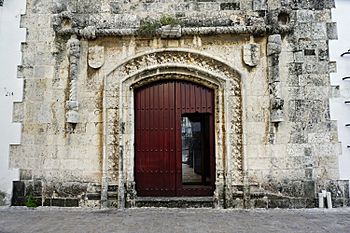
In 1586, Francis Drake captured the city and demanded money to leave. Drake's attack showed that Spain's power in the Caribbean was weakening. In the early 1600s, Spanish policies led to most of the island outside the capital becoming empty. In 1655, an expedition sent by Oliver Cromwell attacked Santo Domingo. But they were defeated. The English troops then took the less protected colony of Jamaica instead. In 1697, the Treaty of Ryswick made Spain officially recognize France's control over the western third of the island, which is now Haiti.
In 1605, Spain was unhappy that Santo Domingo was trading with other European powers. So, Spain attacked large parts of the colony's northern and western regions. They forced people to move closer to Santo Domingo city. This action, known as the devastaciones de Osorio, was terrible. More than half of the moved colonists died from hunger or sickness. Santo Domingo city also suffered from a smallpox outbreak, crop diseases, and hurricanes.
In the 1600s, the French started settling the empty western third of Hispaniola. In 1625, French and English pirates arrived on the western side of the island. Spanish forces attacked these pirates in 1629. They expelled the French and English. In 1654, the Spanish re-captured the west side of the island.
However, in 1655, the English and French reoccupied western Hispaniola. In 1660, the English appointed a Frenchman as governor. He declared loyalty to the King of France and defeated English attempts to take back the island. In 1665, King Louis XIV officially recognized French colonization of the island. The French colony was named Saint-Domingue. By 1670, a Welsh privateer named Henry Morgan invited pirates from Tortuga island to sail with him. They were hired by the French. This helped France gain a stronger hold on the Caribbean. The pirates did not truly control the island but used Tortuga as a safe hideout. The capital of the French Colony of Saint-Domingue moved from Tortuga to Port-de-Paix on Hispaniola in 1676.
In 1680, new laws in England stopped sailing under foreign flags. This was a big blow to Caribbean pirates. Agreements in the Treaty of Ratisbon of 1684, signed by European powers, ended piracy. Most pirates were then hired by royal navies to fight their former allies. In the 1697 Treaty of Ryswick, Spain officially gave the western third of the island to France. This area became an important port for goods moving to and from France and Europe.
French and Spanish colonists continued to have small fights. This happened even after the 1697 treaty. These fights also continued despite a 1731 agreement that partly set a border between the two colonies. In 1777, the Treaty of Aranjuez finally set a clear border. This ended 150 years of local conflicts and attempts to control the whole island.
Economic Growth and Piracy
In 1700, the House of Bourbon took over in Spain. They made economic changes that slowly helped trade in Santo Domingo grow again. The Spanish crown gradually made trade rules less strict. This helped trade between Spain and its colonies, and among the colonies themselves. The last large merchant fleets sailed in 1737. The system where only certain ports could trade was soon ended. Many Spanish and Hispaniola-born Creoles also became pirates and privateers.
By the mid-1700s, more people moved to the colony from the Canary Islands. They resettled the northern part of the colony and grew tobacco in the Cibao Valley. More enslaved people were also brought in.
The Age of Privateers
Santo Domingo's exports greatly increased. The island's farms produced more goods. This was helped by Spain being involved in the Seven Years' War. This allowed privateers from Santo Domingo to hunt for enemy merchant ships. Dominican privateers captured British, Dutch, French, and Danish ships throughout the 1700s. Dominicans were part of the groups that fought under Bernardo de Gálvez during the conquest of British West Florida (1779–1781).
Dominican privateers had already been active in the War of Jenkin's Ear years before. They greatly reduced enemy trade in the West Indies. The goods they captured were brought back to Santo Domingo. There, they were sold to the colony's people or to foreign merchants. During this time, Spanish privateers from Santo Domingo sailed into enemy ports. They looked for ships to rob, disrupting trade in the Atlantic.
As a result, Spanish privateers often returned to Santo Domingo with their ships full of captured goods. These goods were sold in Hispaniola's ports. The money earned from these acts of piracy was used to help the colony's economy grow. It also led to more people moving from Europe. The number of enslaved people in the colony also grew a lot. Many enslaved Africans were taken from enemy slave ships in the West Indies.
By 1791, the population of Santo Domingo grew to about 125,000 people. Of these, 40,000 were white landowners. About 70,000 were free people of mixed race. Around 15,000 were enslaved Black people. This was very different from the nearby French colony of Saint-Domingue (Haiti). Saint-Domingue had over 500,000 enslaved people, making up 90% of its population. This was seven times more than in Spanish Santo Domingo. The French had become the richest colonists in the Western Hemisphere by exploiting their large enslaved population.
As trade rules became less strict, the French leaders of Saint-Domingue became the main buyers for Santo Domingo's exports. These included beef, hides, mahogany, and tobacco. The Spanish settlers, whose blood was now mixed with Taínos, Africans, and Canary Islanders, felt proud. They believed they were the true owners of the island, with the blood of the heroic conquistadores (conquerors) in their veins.
Later Years and French Control
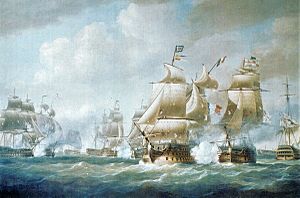
When the Haitian Revolution began, wealthy city families connected to the Spanish government left the island. However, most of the rural cattle ranchers stayed, even though they lost their main market. The Spanish crown in Europe saw the unrest as a chance to take all or part of the western region of the island. They made an alliance with the rebellious enslaved people. The Spanish governor of Santo Domingo paid mulatto and Black rebel leaders and their armies to join him. In July 1793, Spanish forces, including former enslaved people, crossed the border. They pushed back the disorganized French forces.
Even though Spanish and Dominican soldiers were successful on the island against the French, Spain lost the War of the Pyrenees in Europe. On July 22, 1795, France and Spain signed the Treaty of Basel. French soldiers were to return to their side of the Pyrenees in Europe. Spanish Santo Domingo was to be given to France. This period was called the Era de Francia (French Era). It lasted until 1809. Then, the Dominican general Juan Sanchez Ramirez recaptured the island in the reconquest of Santo Domingo.
Cities and Towns Established
| Cities and towns | Foundation |
|---|---|
| Isabela | 1492 |
| Concepción de la Vega | 1494 |
| San Antonio de Bonao | 1494 |
| Santiago de los Caballeros | 1495 |
| Santo Domingo | 1496 |
| San Felipe de Puerto Plata | 1499 |
| Santa Cruz del Seybo | 1502 |
| Santa María de la Vera Paz | 1503 |
| Les Cayes | 1503 |
| Lares de Guaba | 1503 |
| Salvaleón de Higüey | 1503 |
| San Juan de la Maguana | 1503 |
| Compostela de Azua | 1504 |
| Villanueva de Yáquimo | 1504 |
| Puerto Real de Bayajá | 1504 |
| La Buenaventura | 1504 |
| Cotuy | 1505 |
| San Fernando de Monte Cristi | 1506 |
| Hato Mayor del Rey | 1520 |
| Sabana Grande de Boyá | 1535 |
| Neyba | 1546 |
| Peralvillo | 1601 |
| San Juan Bautista de Bayaguana | 1606 |
| Monte Plata | 1606 |
| Concepción de Hincha | 1704 |
| Santa Bárbara de Samaná | 1756 |
| Sabana de la Mar | 1760 |
| Saint-Raphaël, Haiti | 1761 |
| San Gabriel de Las Caobas | 1763 |
| Baní | 1764 |
| San Miguel de la Atalaya | 1768 |
| San Francisco de Macorís | 1778 |
| San José de los Llanos | 1779 |
| Las Matas de Farfán | 1780 |
Society and Culture
Education in Santo Domingo
The St. Thomas Aquinas University, now called the Autonomous University of Santo Domingo, was the first university in the Americas. It was founded in 1538 in Santo Domingo by a special order from the Pope. The university's main building was the Church and Convent of los Dominicos. It started as a seminary run by Catholic monks. Later, Pope Paul III gave it a university charter in 1538.
The new university was designed like the University of Alcalá in Spain. It became a symbol of Spanish ideas during the Spanish Conquest. In 1558, it received its royal charter and was named the University of Saint Thomas Aquinas. The university closed in 1801 when the French took over. But it reopened in 1815 as a non-religious school.
Religion in the Colony
The Archdiocese of Santo Domingo was the first important church center in America. It is the oldest surviving church area in the Americas. The Diocese of Santo Domingo was created on August 8, 1511, by Pope Julius II. At that time, there was also a diocese in Concepción (now in La Vega, Dominican Republic). In 1527, the Concepción de la Vega diocese was closed. This left the entire island of Hispaniola under the control of the bishop of Santo Domingo.
It became a Metropolitan Archdiocese on February 12, 1546, by Pope Paul III. Its first archbishop was Alonso de Fuenmayor. Other important church areas like Puerto Rico, Venezuela, Cuba, and Honduras were once part of its control.
Government and Laws
The Real Audiencia of Santo Domingo was the first high court of the Spanish crown in America. It was created by Ferdinand V of Castile in 1511. Charles V put it into action in 1526. This court later became part of the Viceroyalty of New Spain.
The president of the audiencia was also the governor and captain general of Santo Domingo. This gave him a lot of power and freedom to rule over Spanish lands in the Caribbean. It also covered most of the nearby mainland coasts. The judges of the audiencia also had legal power over the region. This meant the Santo Domingo Audiencia was the most important political group in this area during the colonial period.
|
Native Rights and the Encomienda System
In 1501, Queen Isabella declared that Native Americans were subjects of the Spanish crown. This meant that enslaving them was mostly illegal, except in very specific situations. This rule led to the need to bring African slaves to the island in the years that followed. Native chiefs were responsible for keeping track of the workers in their communities. The encomienda system did not give people land directly. However, it helped the Spanish conquerors and settlers get land to build new towns. At first, the encomendero (the Spanish person in charge) and his family were expected to keep these grants forever.
The encomiendas became very unfair and harsh. In the area of La Concepción, north of Santo Domingo, the Spanish leader heard rumors. He heard that 15,000 Taínos were planning a rebellion. When he heard this, he captured the Taíno caciques (chiefs) involved and had most of them executed.
Later, a chief named Guarionex caused a lot of trouble in the countryside. An army of about 3,090 Spanish soldiers defeated the Ciguana people under his leadership. The islanders wanted to join the Spanish forces, hoping for protection from warring tribes. They helped the Spanish learn about the local environment. The rule that encomiendas should return to the crown after two generations was often ignored. The colonists did not want to give up the labor or power.
Images for kids
See also
 In Spanish: Capitanía general de Santo Domingo para niños
In Spanish: Capitanía general de Santo Domingo para niños
- List of colonial governors of Santo Domingo
- Timeline of Santo Domingo
- History of the Dominican Republic
- Spanish colonization of the Americas
- Spanish occupation of the Dominican Republic
- French Colony of Saint-Domingue




